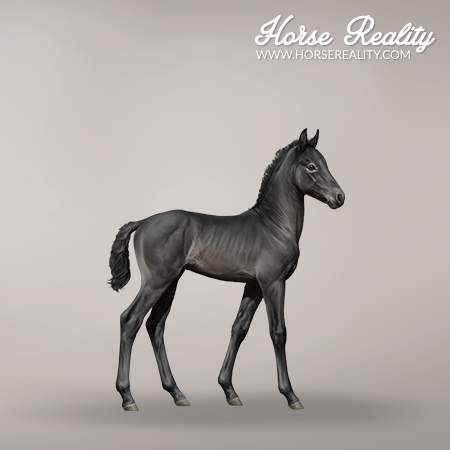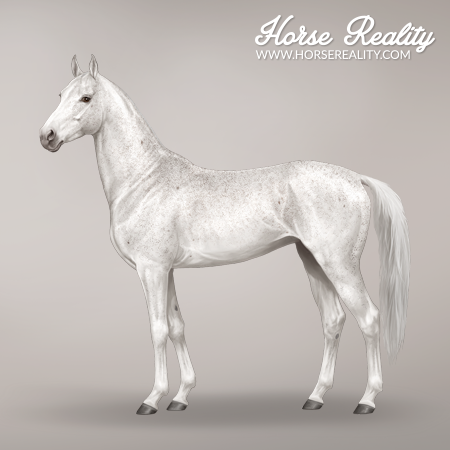The ageing process of Horse Reality horses does not follow the average pace of real-life time. One year in the game is 16 real-life days. This means horses become 1 month older every 32 real-life hours. The ageing rollover happens at 24:00 (00:00) HR time (which differs from the manual daily rollover players click at the start of their day). Because this check occurs every 24 hours and horses age every 32 hours, horses will not age every rollover.
¶ Life Events & Time
| Event | Real-Life Time |
|---|---|
| 1 in-game month | 32 real-life hours |
| 1 in-game year (12 months) | 16 real-life days |
| Horse pregnancy | 13.5 - 17 days |
| Failed pregnancy | 48 hours (2 days) after covering |
| Miscarriage in 4th/5th month of pregnancy | 96 hours (4 days) after covering |
| Ultrasound available | 120 hours (5 days) after covering |
| Birth | 30 real-life minutes (max.) |
| Weaning (6 months) | 8 real-life days from newborn to weaned foal |
| Adulthood (3 years) | 48 real-life days (about 1.5 months) from newborn to adult horse |
| Clinical Approved predicate available for stallions (7 years) | 112 real-life days (almost 4 months) |
| Death (from 25-30 years) | 400 – 480 days (about 13-16 months) lifespan |
¶ Stages of Life
¶ Pregnancy & Birth
From the moment of covering to birth, it takes between 13.5 to 17 real-life days. There is no way to speed up pregnancies. More details can be found in the article about breeding.
¶ Newborn Foal
A newborn foal will stay by the side of its mother and does not require a stall of its own for the first six months of its life. Pay extra attention when retiring or selling one of the two, as they share a stable (more information about that in the respective articles).
Foals are born with 100% affection towards you and 0% physical fitness. This is a good time to start basic training with your foal. This way, when grown up, it will have learned the basics of horse behaviour and is ready for further education in a discipline. Additionally, the training will increase the foal’s physical fitness and keep its affection high.
Horses are foals until they reach three years of age. Foals can be entered in conformation shows from the moment of their birth on, but cannot be trained in a discipline and therefore not yet compete in competitions.
¶ Six Months of Age – Weaning
Once a foal is six months old, it leaves its mother's side and requires a stall of its own. This moment in a foal’s life is called weaning. The last task of the first level of the basic training is also called weaning and is meant to prepare your foal for this crucial event. However, at six months old your foal will leave its mother’s side, whether or not you have completed the task. It will even do so if you are over your stable capacity. Once a foal is six months old, it can be sent to Kai‘s foal pastures.
¶ Three Years of Age – Adulthood
Once a horse becomes three years old, the carefree days are over and adulthood begins! This is most prominently marked by the horse’s artwork changing from foal to adult.
Now that the horse is adult, you can breed new foals with it: mares can become pregnant and stallions can cover mares. Another marker of adulthood is that provided the horse has completed all four basic training levels, you can choose which discipline you want it to train and then compete in. This decision is permanent and cannot be reversed. If the horse has not yet completed its basic training, this can still be started at any point during its adulthood.
¶ Death
All horses will die naturally from old age between the ages of 25 years and 30 years. This is decided by chance and can happen any day once a horse is within this time frame. Right now there is no upper age limit for breeding and competing, and horses do not get any penalties due to old age or being pregnant.
When a horse passes away, any tack or backgrounds equipped to the horse will return to your inventory.
¶ Artwork and Ageing
Artwork changes only once in a horse’s life: when it becomes an adult at 3 years of age. There is no separate artwork for newborns or yearlings or for elderly horses. Grey horses, for example, will not progress in greying as they become older.
Some coat colours are invisible on foals and only show up in adult artwork, for example, roan, rabicano and sooty. When buying a foal that is being advertised to carry such a colour, be sure to check its pedigree and colour genes!
There are some coat colours that are visible in the foal’s artwork, though they might become more explicit in the adult version. For example, the mane and tail of flaxen chestnut foals are visibly lighter than that of regular chestnuts. Grey foals show their normal coat colour, but their coat is richer in colour due to hyperpigmentation and they will appear to have lighter hair around their eyes and muzzle.
 |
 |
| Example of a grey Akhal Teke's artwork from foal to adult | |
¶ Artificially Ageing a Horse (DP Ageing)
If you are too impatient to wait for your horse to age up naturally, you can speed up the process. This can be done on the Info tab of a horse’s profile, where horses can be aged in 6 months increments for 75 DP per ageing. This will not affect the pregnancy duration of mares. If a pregnant mare is aged using DP, she will become older but her pregnancy will not be shortened.

¶ Changelog
- On June 19th 2024, a bugfix to stop certain horses from dying outside of the 25-30 years range was implemented[1]